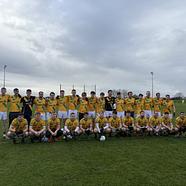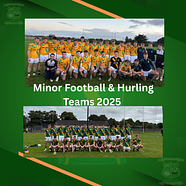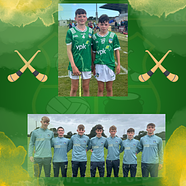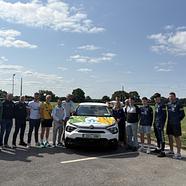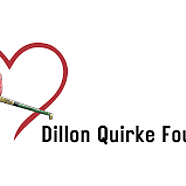Colleagues, in the interest of player welfare, health and safety and the overall well-being of all our members of Atháin CLG club, the senior committee has decided that is vital that all mentors, selectors, coaches and managers be aware of the danger of CONCUSSION and the potential outcomes if proper protocol is not followed regarding concussion.
Whilst all type of injury are a concern, CONCUSSION is worthy of particular mention due to not just the actual event of being concussed but more importantly, the immediate aftermath and thereafter, 24 hrs-72hrs (and even further). It is a potential mine field including making the right judgement calls in the first place to making a judgement call regarding a return to play, not to mention trying to convince a player that he is concussed in the first place.
Unfortunately the reality of all contact sports bring with it the potential for minor and serious injury. On rare occasions even potential for worse.
In an ideal world there would be suitably qualified medical personnel in attendance for every training session and match but until that is a reality the club has decided to be proactive in this area, bearing in mind the potential for serious and undesirable health outcomes regarding concussion.
The following are just guidelines until a more comprehensive protocol is drawn up nationally by the GAA.. The club is also cognisant of the current responsibilities heaped on all mentors and coaches who give their time voluntarily.
Concussion?
A Concussion is a brain injury: Concussions can occur without a loss of consciousness:
All concussions are serious:
All athletes with any symptoms following a head injury must be removed from playing or training and must not return to activity until all symptoms have cleared.
SPECIFICALLY, return to play on the day of any suspected concussion is forbidden.
RECOGNISE & REMOVE to help prevent further injury or even death.
Unfortunately the stark reality is that concussion can be FATAL.
However the vast majority of concussions recover with physical and mental rest.
What is Concussion?
Concussion is a traumatic brain injury resulting in a disturbance of brain function. There are many symptoms of concussion, common ones being headache, dizziness, memory disturbance or balance problems.
Loss of consciousness, being knocked out, occurs in less than 10 per cent of concussions. Loss of consciousness is not a requirement for diagnosing concussion.
Typically standard brain scans are normal.
What causes concussion?
Concussion can be caused by a direct blow to the head, but can also occur when blows to other parts of the body result in rapid movement of the head e.g. whiplash type injuries.
Who is at risk?
Concussions can happen at any age. However, children and adolescent athletes:
• are more susceptible to concussion
• take longer to recover
• have more significant memory and mental processing issues
• are more susceptible to rare and dangerous neurological complications, including death caused by a single or secondary impact.
Players with a history of two or more concussions within the past year are at greater risk of further brain injury and slower recovery and should seek medical attention from practitioners experienced in concussion management before return to play.
Onset of Symptoms:
It should be noted that the symptoms of concussion can present at any time, but typically become evident in the first 24-48 hours following a head injury.
How to recognise a concussion:
If any of the following signs or symptoms are present following an injury the player should be suspected of having a concussion and immediately removed from play or training.
Visible clues of concussion - What you see:
Any one or more of the following visual clues can indicate a concussion:
• Dazed, blank or vacant look
• Lying motionless on ground / slow to get up
• Unsteady on feet / balance problems or falling over / Loss of coordination
• Loss of consciousness or responsiveness
• Confused / not aware of plays or events
• Grabbing / clutching of head
• Seizure (fits)
• More emotional / irritable than normal for that person
Symptoms of concussion - What you are told:
Presence of any one or more of the following signs and symptoms may suggest a concussion;
• Headache
• Dizziness
• Mental clouding, confusion, or feeling slowed down
• Visual problems
• Nausea or vomiting
• Fatigue
• Drowsiness / feeling like “in a fog“ / difficulty concentrating
• “Pressure in head”
• Sensitivity to light or noise
Questions to ask - What questions:
Failure to answer any of these questions correctly may suggest a concussion.
“What venue are we at today?”
“Which half is it now?”
“Who scored last in this game?”
“What team did you play last week / game?”
“Did your team win the last game?”
RECOGNISE AND REMOVE, IF IN DOUBT SIT THEM OUT.
On field management of a suspected concussion:
Any athlete with a suspected concussion should be IMMEDIATELY REMOVED FROM PLAY, using appropriate emergency management procedures.
Once safely removed from play they must not be returned to activity that day and until they are assessed medically.
If a neck injury is suspected the player should only be removed by emergency healthcare professionals with appropriate spinal care training.
Teammates, coaches, match officials, team managers, administrators or parents who suspect a player may have concussion MUST do their best to ensure that the player is removed from the field of play in a safe manner.
Side-line management of a suspected concussion:
Athletes with a suspected concussion:
• Should not be left alone in the first 24 hours
• Should not consume alcohol in the first 24 hours and thereafter should avoid alcohol until
provided with medical or healthcare professional clearance or if no medical or healthcare professional advice is available the injured player should avoid alcohol until symptom free
• Should not drive a motor vehicle and should not return to driving until provided with medical or healthcare professional clearance or if no medical or healthcare professional advice is available should not drive until symptom free.
If ANY of the following are reported then the player should be transported for urgent medical assessment at the nearest hospital:
• Athlete complains of severe neck pain
• Deteriorating consciousness (more drowsy)
• Increasing confusion or irritability
• Severe or increasing headache
• Repeated vomiting
• Unusual behaviour change
• Seizure (fit)
• Double vision
• Weakness or tingling / burning in arms or legs
In all cases of suspected concussion it is recommended that the player is referred to a medical or healthcare professional for diagnosis and guidance, even if the symptoms resolve.
Managing a concussion or suspected concussion:
Rest the Body, Rest the Brain
Rest is the cornerstone of concussion treatment. This involves resting the body, ‘physical rest’, and resting the brain, ‘cognitive rest’.
This means avoidance of:
• Physical activities such as running, cycling, swimming etc.
• Cognitive activities such as school work, homework, reading, television,
This complete rest should be for a minimum of 24 hours.
Before re-starting activity the player must be symptom free at rest.
Medical or approved healthcare provider clearance is recommended before re-starting activity.
Children and adolescents should be managed more conservatively. International best practice recommend children and adolescents should not play or undertake contact training for a minimum of two weeks following cessation of symptoms. Students must have returned to school or full studies before re-commencing exercise.
After the minimum rest period AND if symptom free at rest a Graduated Return to Play (GRTP) programme should be followed.
Graduated Return to Play (GRTP) programme:
A Graduated Return to Play (GRTP) programme is a progressive exercise programme that introduces an athlete back to sport in a step wise fashion. This should only be started once the athlete is symptom free and off treatments that may mask concussion symptoms, for example drugs for headaches or sleeping tablets.
The GRTP programme contains six distinct stages:
• The first stage is the recommended rest period.
• The next four stages are training based restricted activity
• Stage 6 is a return to play
Under the GRTP programme, the player can proceed to the next stage only if there are no symptoms of concussion during rest and at the level of exercise achieved in the previous GRTP stage.
If any symptoms occur while going through the GRTP programme, the player must return to the previous stage and attempt to progress again after a minimum 24-hour period of rest without symptoms.
It is recommended that a medical practitioner or approved healthcare professional confirm that the player can take part in full contacts training before entering Stage 5.
GRTP Protocol – each stage is a minimum of 24 hours
Rehabilitation Stage Exercise Allowed Objective:
1. Minimum rest period. Complete body and brain rest without symptoms Recovery
2. Light aerobic exercise; Light jogging for 10-15 minutes, swimming or stationary cycling at low to moderate intensity. No resistance training.
Symptom free during full 24-hour period. Increase heart rate:
3. Sport-specific exercise, Running drills. No head impact activities. Add movement
4. Non-contact training drills Progression to more complex training drills, e.g. passing drills.
May start progressive resistance training.
Exercise, coordination, and cognitive load:
5. Full Contact Practice Normal training activities. Restore confidence and assess functional skills by coaching staff
6. Return to Play. Player rehabilitated. Recover
It is recommended that, in all cases of suspected concussion, the player is referred to a medical professional for diagnosis and guidance as well as return to play decisions, even if the symptoms resolve.
A comprehensive medical concussion evaluation may include:
• An analysis of symptoms
• A general and neurological examination
• Verbal cognitive (memory) tests
• A balance assessment
• Computerised brain function tests
Each of these is useful in contributing to a diagnosis and return to play (RTP) decision but no one test stands alone in determining return to play.
CONCUSSION - RECOGNISE AND REMOVE
We hope that the aforementioned information will be of benefit to both you and the players under your mentorship. We also appreciate that you may be unfamiliar with some of the terminology used.
Indeed if you have any questions or concerns regarding the above please do not hesitate to contact the club via our Health and Wellness officer, Sean Carey or any of the Senior committee


